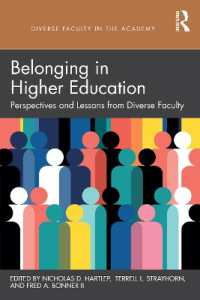- ホーム
- > 洋書
- > 英文書
- > Religion / Ethics
Full Description
This book provides an insight into the complex entanglements of Sufi groups in the region of Ottoman and post-Ottoman Europe through a wide range of cross-disciplinary discourses. It explores the multiple contacts, interactions, and exchanges of Sufi communities with each other as well as with other religious and non-religious groups, and the often-conflictual entanglements of discourses, narratives, and traditions.
Contents
1 Entangled Sufism in (Post)Ottoman Europe: An Introduction 2 The Amalgamation of two Religious Cultures: the Conceptual and Cultural History of Alevi-Bektashism 3 Body of the Shāh: Entangled Portraits in Bektashi and Alevi Religious Space 4 Turkish Sufism as seen by Western Esotericists in the 20th Century 5 Post-Ottoman Idealisation and Transspatial Entanglements within German Sufism 6 Places of Remembrance or Remembrance of Places? Social Memory and the Transformation of the Sufi Lodges in Republican Turkey 7 Modifications of a Sacred Place: Gul Baba's Tomb from the 17th Century to Post-Communist Times 8 Entangled Ambiguities: Sari Saltuk, St. George and the Dragon in Eastern Europe 9 The Revival of the Mesnevihan in Sarajevo: Entanglements of Urban Sufism 10 Building Sufi Authority: The Pilgrimage of Sheh Ali Coban in Caja as a Multi-Layered and Entangled Practice 11 Communicating the Mystical?: An Exploratory Case Study on the Imagined Sufi Communities through the use of Social Media 12 From Entanglement to Disentanglement and to Re-Entanglement?: Competitive Interconnections among the Albanian and Turkish Bektashis in Macedonia 13 Subjective Sacralising: Contradictory Naqshbandi Perspectives on Neo-Ottoman Involvement in Bosnia and Herzegovina








